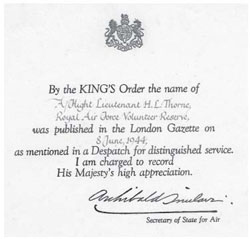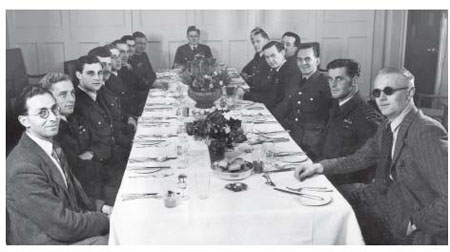A Very Unusual Air War (40 page)
Read A Very Unusual Air War Online
Authors: Gill Griffin

12 July
: The Oxford flight was for a local army officer (‘Brown Job’) from the searchlight post.
14 July
: It was about this time that the first V1 flying bombs started to be used against England. The Tempest was one of the planes that were fast enough to catch a V1 in level flight, hence the continued interest in top speeds.
15 July
: Weather tests in July? Must have been a period of anticyclonic gloom!
16 July
: The first flight was cut short when I saw a black stream of oil pouring back from the NAFDU Hellcat’s engine cowling. The Fleet Air Arm pilot just managed to land before the engine seized up. The trouble proved to be nothing serious, just a loose filler cap.
These flights were for the deliberate ejection of smoke for the purpose of laying down a smoke screen.
19 July
: This was low-level bombing using 20 lb. smoke bombs. For these trials we did not use the Holbeach coastal ranges but a disused, small grass airfield. A very low approach at a fast cruising speed was exciting but the accuracy was poor.
23 July
: I am puzzled by this entry as nickel (code name for strips of aluminium foil) was used by bombers to confuse radar. I can only assume that this was a co-operation exercise with Bomber Command.
28 July
: On a nice, bright, sunny summer day it was very pleasant to buzz around in a Mustang but with the moulded bubble or teardrop canopy, it could get very warm in the cockpit. I used to wear a pair of white drill overalls and on one occasion I wore only a pair of trunks underneath. Due to a minor fault I had to land away from base to get it fixed, which should have taken only a few minutes. In fact, it took three hours and I was stuck with the aeroplane, unable to visit the Officers’ Mess for a drink or a snack. It taught me a sharp lesson and I did not repeat the lightweight dress code!
| Summary for:- July 1944 | 1. Spitfire | 10–05 |
| Unit:- AFDU Wittering | 2. Mustang | 5–55 |
| Date:- 4/8/44 | 3. Proctor | 2–40 |
| Signature:- H.L. Thorne | 4 Tempest | 1–05 |
| 5. Oxford | 1–10 | |
| | ||
| Signed: T.S. Wade S/Ldr O/C Flying AFDU |


| YEAR | 1944 | AIRCRAFT | Pilot or 1st Pilot | 2nd Pilot, Pupil or Pass. | DUTY (Including Results and Remarks) | Flying Time | Passenger | ||
| MONTH | DATE | Type | No. | Dual | Solo | ||||
| August | 3rd | Spitfire V | AD318 | Self | | Air test | | −10 | |
| | 4th | Spitfire IX | BS552 | Self | | Bombing | | −45 | |
| | | Spitfire IX | MH415 | Self | | Bombing | | −45 | |
| | 6th | Spitfire V | AD318 | Self | | Photography | | −35 | |
| | 7th | Spitfire IX | MH415 | Self | | Bombing | | −40 | |
| | 9th | Spitfire V | AD318 | Self | | Photography | | −20 | |
| | | Spitfire IX | 251 | Self | | 1 × 500lb bomb & 2 × 250lb bombs | | −55 | |
| | | Proctor | DX220 | Self | F/Lt Simms, LAC Hunt | To Doncaster | | −45 | |
| | | Proctor | DX220 | Self | F/Lt Simms, LAC Hunt | Doncaster to Wittering | | −35 | |
| | 10th | Spitfire XIV | 650 | Self | | To Westcott | | −40 | |
| | | Spitfire XIV | 650 | Self | | To base | | −30 | |
| | 11th | Mustang III | FZ107 | Self | | Bombing | | 1–00 | |
| | | Proctor | DX220 | Self | Mr Gould | Farnborough via Sutton Bridge | | 1–40 | |
| | | Proctor | DX220 | Self | Mr Gould | To base | | −50 | |
| | 12th | Mustang III | FZ107 | Self | | Bombing | | 1–05 | |
| | 13th | Boston | BZ363 | Self | | Local | | −40 | |
| | 14th | Spitfire XIV | RH179 | Self | | Test curved windscreen | | −30 | |
| | | Spitfire XIV | RM689 | Self | | Test curved windscreen | | −30 | |
| | 17th | Spitfire V | AD318 | Self | | Film Corsair | | 1–00 | |
| | | Spitfire V | AD318 | Self | | Film Corsair | | −10 | |
| | 20th | Spitfire IX | MH415 | Self | | Air test | | −10 | |
| | 23th | Spitfire V | AD318 | Self | | Film Corsair | | −30 | |
| | 24th | Tempest | 757 | Self | | Local | | −35 | |
| | 25th | Mustang III | FZ107 | Self | | Local | | −35 | |
| | | Mustang III | FZ107 | Self | | Bombing | | 1–10 | |
| | 26th | Spitfire V | AD318 | Self | | Film Corsair | | −45 | |
| | 27th | Boston III | ? | Self | | Local | | −30 | |
| | 29th | Anson | 184 | Self | LAC Hunt | To Doncaster | | −35 | |
| | 30th | Anson | 184 | Self | LAC Hunt | To base | | −35 | |
| | 31st | Spitfire IX | JL359 | Self | | GGS dive bombing | | −45 | |
| | | | | | | GRAND TOTAL TO DATE 1,057 hours 10 mins | 3–30 | 11–20 | |
| | | | | | | | 60–00 | 982–20 | 16–15 |
9 August
: We photographed the bomb release at various heights and speeds.
A Spitfire IX flew perfectly with ½ ton of bombs, a 500 pounder under the belly and a 250 pounder under each wing, with a full load of fuel and ammunition.
The Doncaster trip was interesting as we landed on what is now Doncaster horseracing track.
10 August
: Another trip to see the old folks at home but I was somewhat delayed by the interest shown in my Mk XIV Spitfire, at that time the latest model and probably the most advanced fighter in the world. With its high speed, phenomenal rate of climb and an operational ceiling of over 40,000 feet, it attracted attention from all ranks at Westcott. An OUT using Wellingtons for operational training, their usual sight of a fighter was a ME109 or a FW190 attacking them.
Before returning to base I gave them a short aerobatic display, ending with a battle climb up and out of sight.
11 August
: Our test programme on the Mustang III was more or less finished and it, too, was relegated to carrying bombs and rockets. We gave it the thumbs-up in every respect and it went into service with the RAF and USAAF in ever-increasing numbers. In the opinion of most of the fighter pilots I knew, the Spitfire prevented us from losing the war and the Mustang enabled us to win it.
Many of our experimental flights involved mathematical calculations to ascertain heights and true air speeds. The latter varied by approximately 1.5% according to altitude. Mr Gould was a civilian technician, attached to the unit; we became good friends.
13 August
: After many trips as a passenger I finally flew the Douglas Boston as pilot. (Strange that no one volunteered to be a passenger on this trip. Cowards!) The Boston was another very pleasant aircraft to fly and, with its tricycle undercarriage, easy to handle on the ground. The two powerful Wright Cyclone radial engines made this a really potent aeroplane.
14 August
: Night flying. The windscreen of Spitfires was normally a thick flat piece of bulletproof, laminated plastic to protect the pilot from injury to the head and upper body in the event of a head-on attack, or return fire from the rear gunner of an enemy bomber. RM689 was used as an experimental aircraft with a modified curved windscreen, which was tried out by the pilots of AFDU in various daylight conditions. I cannot think why it was thought necessary to test it out at night as, at that stage of the war, there was no way that a Spitfire could again be used at night.
Wimpy Wade and I undertook the night flying trial, taking turns in the two aircraft. I flew RM689 first then we swapped and it was Wimpy’s turn in the modified machine. After a midnight take-off, we flew to The Wash to fire all guns and cannon. The muzzle flash severely affected our night vision. Again on landing there were streams of sparks from the exhaust stubs when the throttle was closed. Despite this I made both landings without any trouble but Wimpy held off too high on his first approach and had to go round again. On his second attempt he hit the ground hard and bounced badly; at full throttle, he failed to make sufficient allowance for torque and pulled away in a vicious left-hand turn. Where his port wingtip hit the ground it left a 30-yard furrow but he got away with it. On the third approach he did better and got down without further damage. Badly shaken, the only time I ever saw him in that state, he needed a drink but, as the Officers’ Mess was closed, we repaired to Chain Cottage. There, with some help from a sleepy Estelle, we saw off a bottle of gin.
